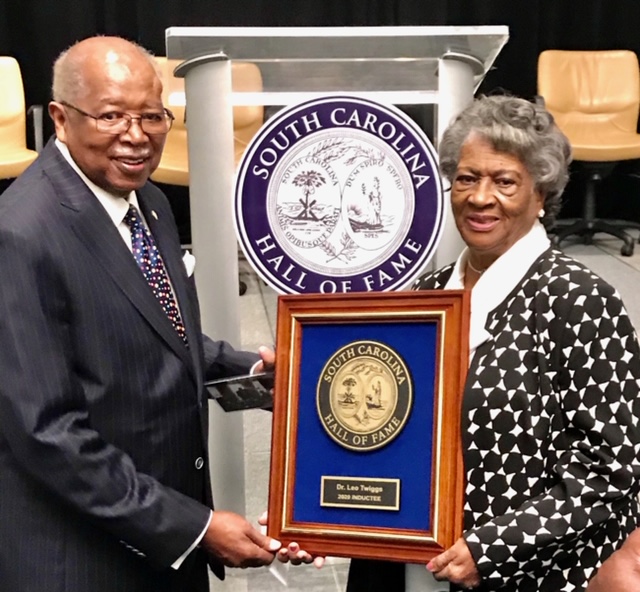
Dr. Leo Twiggs and his wife at his induction to the South Carolina Hall of Fame.
After years of exploring racism, inequalities, and crises through his art, Dr. Leo Twiggs feels pull of pandemic
An American painter, artist, and educator who grew up in the South, Dr. Leo Twiggs’ phenomenal exhibition Requiem for Mother Emanuel was showcased at the Mint Museum Randolph. Requiem was his artistic response to the massacre of nine church members during a prayer meeting in the historical Charleston house of worship, Mother Emanuel AME Church. Here he shares his thoughts on how the pandemic is affecting his daily routine and inspiring his art, as well as the positive effects he hopes to see after.
Studio location: Orangeburg, S.C.
Describe the artwork you create and medium you use.
Innovative batik painting—wax and dyes on cotton fabric mounted on hard board.
Who are artists that inspire you and your work?
Hale Woodruff, Aaron Douglas, Jackson Pollock, and Joan Miro, among others.
What is your favorite piece or artwork that you created and why?
I work in series. The Commemoration Series (Flags) and the Targeted Man series evolved into Requiem For Mother Emanuel, a series of nine paintings lamenting the victims of the shooting at Mother Emanuel AME Church in Charleston, South Carolina. It is a favorite because it is a place I arrived at after years of exploring the issues of racism and inequalities in our country. Mother Emanuel challenged me to vent my emotions while maintaining the aesthetics and integrity of the creative process. Conversation, the painting at the Mint, is an extension of that new exploration.
How does your environment influence your art?
I was born in the South. The sights, smells, sounds and traditions of the region impact my work, especially the southern African American experience.
Tell us about your new morning routine, including when you start your day and how you spend the early hours.
I paint in spurts, allowing lots of time in between for contemplation. Batik is a slow process and it fits my tempo. I am currently working on a painting commissioned by the Inaugural Committee at Claflin University. When it is complete, I will get back to my regular routine.
Are you finding new inspiration for your art during this shift of perspective in the world?
Yes, just as it was when Hurricane Hugo came through and after 9/11. The Hugo series is on YouTube.
Tell us about your afternoon. Are you working from home, going to your studio?
My studio is attached to my house so I can work all night if I wish. More often I work until late hours after midnight. There is a solitude about the night that I find invigorating.
What positive perspective changes in society would you like to see come from the pandemic
Learning how fragile humanity is, and how insignificant bickering and harboring racial animosities are.
How are you winding down your day? Have any recommendations for stress relievers to settle after another day done?
I am catching up on some reading and some great biopics on Netflix. I like listening to jazz, and the documentary of Miles Davis is elegantly filmed and the music is powerful. I began my work life in 10th grade as a projectionist, so I saw hundreds of movies through high school and college. Now I look for storyline, editing and cinematography. There are some good things out there.
What are you cooking? What’s your comfort food of choice?
My wife is such a good cook that I am spoiled, relegated to great aromas and looking in the pot. Anything she cooks is comforting.
What are you currently reading?
The New York Times Series 1619.
What is your favorite music choice?
All that is jazz.
What is your favorite podcast(s)?
PBS, All Things Considered, and sometimes Phil in the Blanks.